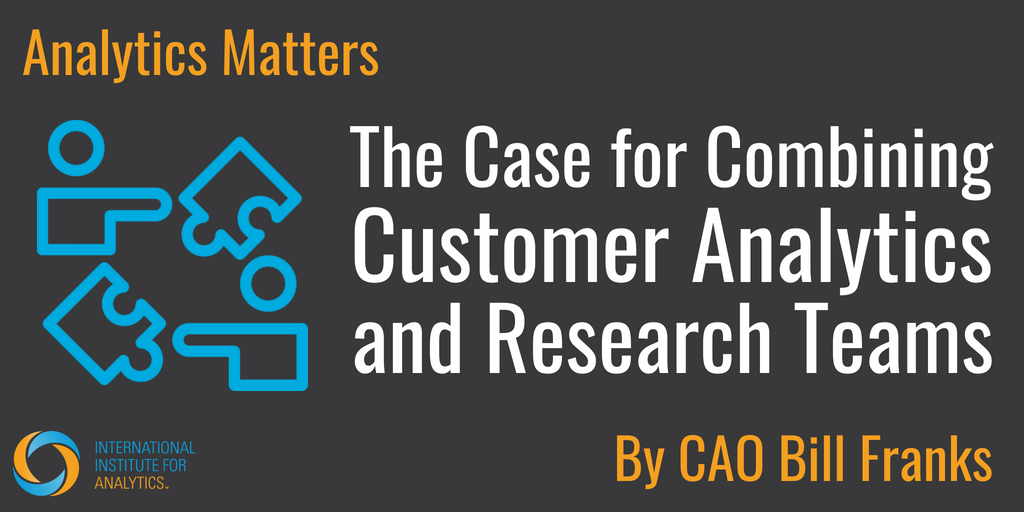

Traditionally, large organizations have both a research organization and a customer analytics organization that are distinct from each other and often in entirely different chains of command. I have seen many organizations where there is tension between these two organizations. Neither seems willing to acknowledge the value of the other and this causes opportunities to be missed. Today, organizations need to challenge the old assumption that these groups should be separated.
In the context of this blog, I am discussing research in the sense of traditional primary research that covers satisfaction surveys, focus groups, etc. I am not referring to research in the sense of medical or technical research such as drug testing, circuit board design, etc. I am also focusing on the customer analytics team since that is the team that deals directly with other types of customer information. While operations or supply chain analytics teams could also benefit from the combining of the groups, the biggest impact will be in the customer realm.
Defining The Differences
Traditional research groups focus on interacting with customers and prospects to understand what they think and say about an organization’s products, brand, and reputation. Whether an in-depth online survey or a lengthy focus group discussion, research activities help an organization stay in touch with its customers as well as the market as a whole.
The data collected by research teams tends to be on a fairly small number of individuals, often in the 10s to 100s range. Total samples can reach 1000s or tens of 1000s over time for a large organization. But, by today’s standards the reach and size of the data is very small. On the other hand, the data collected can be quite rich, detailed, and inclusive of information that can’t be gathered in other ways. For our purposes, let’s say a research team studies what customers say and why customers do what they do.
Customer analytics teams, on the other hand, traditionally deal with data gathered through the flow of business – transaction history, service history, marketing and service interactions, etc. By analyzing the data to uncover patterns and trends, business actions can be better informed. Customer analytics helps organizations better understand the behavior of their customers and react appropriately.
A customer analytics team often uses massive data sources. There may be tens of millions of customers with billions of transactions and trillions of marketing, website, and device interactions. This is the realm of big data by any measure. For our purposes, let’s say a customer analytics team studies what customers actually did, when they did it, and how they did it.
Why The Tension?
Both the research and the analytics teams clearly add value in their own ways. So, why do the teams often resent or dismiss each other? Research teams will complain that none of the customer analytics get at what a customer actually thinks and that masses of data don’t make up for truly understanding a customer’s motivations and preferences. Analytics teams will complain that the research team only sees a small piece of the big picture and that with all of the big data available for customer analytics, research can’t add a whole lot.
Basically, instead of seeing each other as a hammer and a screwdriver – two distinct tools serving distinct purposes – each team sees the other as a less worthy hammer than themselves. Without acknowledging the distinctive value of both groups’ individual efforts, an organization isn’t getting the most from either. At its core, the main difference is how and from where the customer data is gathered – either through a designed study gathered directly from the customer or through business process execution gathered after the fact.
Historically, these groups were separate because they were formed at different points in time by different stakeholders. For example, research teams have been around for many decades while analytics teams have only been around for a few decades in their current forms. In the past there was no imperative to combine or coordinate the groups, and so they usually just go on doing their respective tasks while being oblivious of the other.
How To End The Tension
I am seeing more companies start to merge their customer research and analytics teams under one organization and one senior leader. While this structure is still the exception, IIA’s opinion is that in the coming years it will continue to be adopted. This terrific approach benefits each team as well as the company.
First, while research data may be “small” it still provides critical information. That information should be part of the customer profiles used for analytics right alongside the big data. There is no reason why the valuable information in the data collected by research activities can’t be considered and utilized when designing and executing traditional customer analytics.
Second, there is no reason why research activities can’t be influenced by common customer analytics. For example, specific target groups can be identified through analytics. Also, concerted effort can be made to get research data on a sufficiently representative sample of key customer segments so that the findings can be applied to the entire customer population through attribution techniques.
In a nutshell, combining the teams also combines what a customer says about why they do things with what a customer actually did and how they did it. Identifying the consistencies and inconsistencies between the two can lead to the discovery of improvement opportunities that will be valued by the customer and measurable by the company.
If Your Organization Still Has These Problems, Fix It!
With a little effort and planning, research data can further enable and enhance customer analytics. And, customer analytics can help guide and strengthen research activities. Everyone simply needs to step back and realize that 1) both a hammer and a screwdriver are needed, and 2) better things can be built using both tools together than using just one by itself.
To achieve that, however, will require a shift in attitude and approach. This will likely require the research and customer analytics teams to eventually be joined together under a single leader who mandates combining forces instead of ignoring or battling each other. In the short term, a simple action to take is to start encouraging the analytics and research teams to work together and to coordinate efforts. Is your organization ready to pursue this merger?